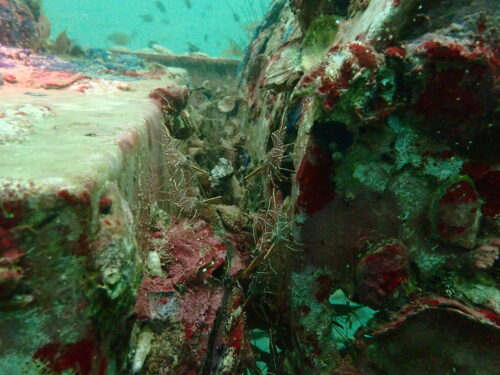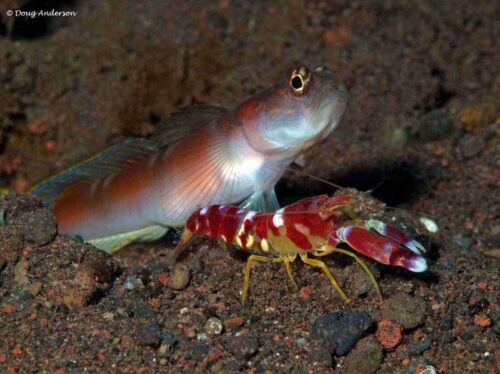Nature’s Perfect Pairs: Discovering Symbiotic Relationships in the Ocean
The natural world is often portrayed as a relentless struggle for survival. But if you look closely enough on your dives, you’ll see another story playing out in parallel: a story of cooperation. The ocean is filled with incredible symbiotic relationships, where different species have evolved to help each other, forming “perfect pairs” to survive and thrive together.
This article in Amadive’s Marine Ecology for Divers series is your field guide to finding and understanding these partnerships. When you know the story behind what you’re seeing, a tiny shrimp is no longer just a shrimp; it’s a courageous “dental hygienist.”
What is Symbiosis? The Forms of Cooperation
Symbiosis is any type of a close and long-term biological interaction between two different biological organisms. The most common form we see while diving is Mutualism, where both partners benefit.
Pair #1: The Clownfish and the Anemone – The Fortress and its Guardian

This is the most classic and universally loved relationship.
- The Context: The sea anemone is a sessile predator, with tentacles full of stinging cells (nematocysts) that can paralyze its prey.
- The Partnership:
- What the anemone gives the clownfish: A perfectly safe home. The clownfish is covered in a special mucus layer that makes it immune to the anemone’s stings. The clownfish’s predators have no such protection, so the anemone becomes an impenetrable fortress.
- What the clownfish gives the anemone: Housekeeping services. The clownfish cleans the anemone, eating parasites and leftover food scraps. Its waste provides nutrients. More importantly, its constant swimming aerates the water, increasing oxygen circulation for its host.
- A Diver’s Observation Guide: Approach slowly. Watch how the clownfish never strays far from its home. You’ll see it “bathing” in the tentacles, and if threatened, it will dive deep inside. In Vietnam, you can easily spot species like the Pink Skunk Clownfish and the Tomato Clownfish.
Pair #2: The Cleaner Shrimp and its “Clients” – The Mobile “Clinic”

This relationship demonstrates an incredible level of trust between predator and potential prey.
- The Context: Large fish like moray eels and groupers are often plagued by parasites and bits of dead skin.
- The Partnership:
- What the shrimp gets: An easy meal. Cleaner shrimps have bright colors and characteristic behaviors to “advertise” their services. They will climb onto large fish, even entering their mouths and gills, to eat parasites.
- What the client (the large fish) gets: Free medical care. The fish gets cleaned, preventing infections. It recognizes the value of the shrimp and will not eat its “doctor.”
- A Diver’s Observation Guide: Look for “cleaning stations,” often a specific coral head or rock outcropping. Be patient and watch from a distance. You will see large fish lining up, patiently waiting for their turn to be serviced. The sight of a fearsome moray eel holding its mouth wide open for a tiny shrimp to clean inside is one of the most incredible displays of trust in the ocean.
Pair #3: The Blind Shrimp and the Goby Fish – The Lookout

This is a brilliant example of compensating for each other’s weaknesses.
- The Context: Certain species of shrimp (like Pistol Shrimp) are excellent burrowers, but they are nearly blind and extremely vulnerable when outside their burrow.
- The Partnership:
- What the shrimp gives: A safe home. It constantly maintains a burrow that both animals share.
- What the goby gives: A sharp pair of eyes. The goby fish stays at the entrance of the burrow, acting as a sentinel.
- The Alarm System: The shrimp will always keep one of its long antennae on the goby’s tail. If the goby senses danger, it gives a specific tail flick. This signal instantly alerts the shrimp, and both retreat into the burrow in a flash.
- A Diver’s Observation Guide: This pair is often found on sandy or silty bottoms. Move extremely slowly and scan the bottom. You will see a small goby “hovering” just in front of a small hole. If you look closely, you may see the antennae of the shrimp at work.
Conclusion: A World of Mutual Support
The ocean is not just a simple food chain. It is a complex web of relationships, and cooperation plays a role just as important as competition. By learning to recognize these perfect pairs, you not only enrich your dive experience but also gain a deeper insight into the ingenuity and interconnectedness of life on Earth.
